From the old town of Gjirokastra to the Ksamil Peninsula, Albania
The first day in Gjirokastra
Short Description. In Gjirokastra, I went to the Old Fortress and then wandered through the traditional Dunavat, Manalat, and Cfake neighborhoods. From there, I crossed a valley and came back to the fortress. Then, I walked down to the ring road of the old town through the Old Bazaar. In the afternoon, I headed to the New Bazaar, where I rambled until evening.
Long Description
From the balcony of my room, I had a view of Gjirokastra’s old town lying at my feet. In the background, I distinguished the mountains which I had struggled to cross the previous day. Mehdi served me a hearty breakfast on the terrace. On a colorful tray, he added a rose freshly picked-up from the garden alongside a cup of Albanian coffee (coffee boiled with sugar and water, until it swells).
After breakfast, I left the guesthouse and passed under an archway covered with vines. From there, I walked a cobblestone narrow alley flanked by two massive whitewashed walls. I climbed up the abrupt street until the slope became too steep and turned into steps, with access directly to the house. The vernacular architecture of Gjirokastra featured solid walls built of stone (apparent or covered with white lavish), vineyard-covered gardens, modest terraces with greenery and flowers, sometimes even small vegetable gardens, as well as customary cats. Despite their picturesque architecture and grace, many houses were abandoned. They had broken windows and doors or gates apparently locked with a harmless padlock. I walked from one house to another and wandered countless streets in search for one that went to the ruined fortress uphill.
Gjirokastra spread at the feet of the Mali and Gjerë Mountains (the Big Mountain). Former Ottoman center of particular importance, it gained the title of “museum town” in 1961. Later, the historic center of Gjirokastra was listed as a UNESCO heritage site due to its rare examples of an architectural character typical of the Ottoman period, as well as for witnessing to a way of life influenced by the traditions of Islam.
Inhabited from ancient times, the historic town of Gjirokastra had been a proof of the cultural diversity of the Balkans: Ottoman housing of the 17th century, the 13th–century fortress, a small Turkish bazaar, a deserted Turkish bath (hammam), an 18th–century mosque (the only one preserved of the 15 ones that had existed) with a Koranic school (madrasa), as well as two churches of the same period. All the buildings were made of stone: from walls to streets, roofs, fountains, and gates. As the town had developed on an abrupt terrain, the slate roof of a house could simply sit next to the basement of another house. The steep streets had been paved with stones of different colors and porosities (black – harsh, gray – smooth, white/pink – polished).
I sauntered among precarious households, where frightened chickens clacked all day long. Eventually, I somehow reached the ruins of the fortress, although not very sure how I did that. The Fortress of Gjirokastra was one of the largest ones in the Balkans. It had 500 meters in length and developed along the ridge of a hill. In the 19th century, Ali Pasha of Tepelena fully restored the fortress and extended it. The ruined fortress included a high brick vaulted gallery that displayed artillery from the WWII, storage rooms, bakeries, and accommodation for the garrison; an entirely preserved clock tower; the ruins of a tank that had been filled up by an aqueduct of which only the supporting pillars remained; the cells of the former prison; the tomb of two wise men (baba) from the Bektashi branch of Shia Islam.
When I exited the fortress, an old woman had displayed her handmade macramé and insisted on selling something to me. The price of an embroidery was insignificant (500 Lk she wrote on a piece of paper – a few euros). I couldn’t refuse to buy one and wanted to help her for an extra little income. When I gave her the money, she kissed my hand and thanked me.
From the fortress of Gjirokastra, I headed to the neighborhoods of Dunavat, Manalat, and Cfake, all of them located on the other side of the hill, opposite to the old town center. The picturesque housing built in Balkan oriental-style had a simple yet unimaginable variety of forms and solutions, from walls made of stone or white-washed facades to large verandas hidden under the shade of lush vines.
The old neighborhoods of the town were organized as displayed on the folds of a wrinkled skirt. The houses were placed on the sunny slopes of the hills, while the valleys between different neighborhoods became residual spaces, filled up with cesspool, briars, and bushes. Occasionally, streets crossed from one neighborhood of the town to another one. Usually, a neighborhood had access via a street at its top end and another one at its bottom end. In this tangled maze of streets and alleys, I managed to find footpaths that connected one neighborhood to another, though. Dogs barked me when I was passing by, cats freaked out. In the middle of the day, the weather was very hot. I had to continuously drink water, although I would be thirsty again after one minute.
I descended into a valley without houses, at the feet of the fortress, walked along the fortress’s imposing tall walls, and reached the Old Bazaar (the neighborhood with houses perched on top of the hill below the fortress’s Clock Tower). A narrow street descended steeply from the edge of the fortress to the ring road of the old town. Tall houses, an old church, and countless dead-ends that led to hidden gardens or courtyards lined up along this street. In a courtyard, I kindly asked a woman hosing down the street to refill my bottle with fresh water. After that, I walked toward the exit of the old bazaar.
Despite the unbearable heat, I climbed up the asphalt road that led to the New Bazaar (under restoration, though). From Qafa e Pazarit (the Neck of the Bazaar), I went to Kujtimi Restaurant, the eatery founded by the Dumi family. They recommended me to try the special dish of Gjirokastra – qifqi (rice balls with eggs and herbs). After lunch, I rambled through the neighborhood that lay below the New Bazaar. On the sloping streets, I noticed an old, nonfunctional mosque made of stone, of which minaret had crashed. On the other side of the road, the former Turkish baths (hammam) wore a neglected look, but still held several stone domes, covered with slates. I returned to the New Bazaar and climbed up other steep streets, often accessible only for pedestrians and flanked by traditional houses with terraces overlooking the mountains.
In the evening, Mehdi offered to me a salad with tomatoes and cheese. Then, he cooked a dish with vegetables picked up right from his nearby garden. I took down my travel impressions until late at night when new room neighbors, who spoke non-stop (her), broke the silence.
The second day in Gjirokastra
Short Description. I went to the Zekate House, located on the outskirts of the old town. Then, I descended to the historic center, to the Skenduli House and the Ethnographic Museum. In the afternoon, I walked through the New Bazaar, then returned to my guesthouse with vines and rustic stone walls.
Long Description
The following day in Gjirokastra, I explored some of the Ottoman houses that created a powerful imprint of the cityscape. The complexity of the 17th–century Ottoman dwellings (called kule) reflected the social and political status of their owners. In fact, they were fortified dwellings with defense towers, developed on several floors: a high, obturated ground floor, built of apparent stone, with tall archways and a large, solid gate displayed on the main façade; then, a more open floor under the roof, usually a bit suspended over the floors below, painted in white lavish, with a large terrace overlooking the landowner’s property (a customary architectural solution used in the Balkans).
The Zekate House sat on a hilltop, on the outskirts of the old town. The Zekates’ still lived next to the house, in a smaller house, and welcomed curious visitors. After visiting the house, I stopped to drink a glass of juice on their terrace overlooking the town. Then, I headed down to the Skenduli House, situated near the Neck of the Bazaar. Mr. Skenduli himself guided me through his family’s house, although he fluently spoke only Italian and no English.
Both houses had a cool space (natural fridge) at the ground floor, a tank with rainwater collected from pipes (musluk), an anti-aircraft bunker, and a kitchen with drainage directly to a collecting ditch placed on the outside wall. The upper floors had rooms for the young (a room for summer and one for winter, with stove) or for the elderly. In the guest rooms (divan), people stood on low sofas, displayed in a typical oriental style along the walls, while the ceiling and the stoves were painted.
Most of the rooms had wooden perforated panels behind which women observed the guests without being seen (according to the Muslim mentality of 1700). The toilet had two doors: you could enter from one side and exit the other side, especially when there were many guests. Next to the toilet, there was a hammam (the equivalent of a hot shower). Additionally, hatches for all sorts of secret connections or shortcuts for women not to be seen existed between floors.
Totally separated from the residential area, the New Bazaar focused exclusively on crafts and handicrafts displayed along several sloping streets, with row-houses (entirely under restoration works, though). I looked in vain for a comprehensive book about Albania throughout the bazaar. Everything was too touristy for my taste, so I headed to the Ethnographic Museum. Built in the traditional Ottoman-style, the museum was erected on the place of the former house of Enver Hoxha (the communist dictator). After I heard the muezzin’s call to prayer from the mosque’s minaret, I went to the Kuka Tavern, where I ordered shapkat (a kind of souffle) and hoshaf (yogurt with figs). I spend the afternoon on the terrace of my guesthouse, from where I studied the movement of the rain clouds and wrote another neighborhood guide for the Arrivedo platform.
From Gjirokastra to Ksamil
Short description. From Gjirokastra, I drove over a mountain pass from where I descended to Syri I Kaltër. At the Ionian Sea, I stopped in Sarandë and then continued to the south, toward the Ksamil Peninsula.
Long Description
In the morning, Mehdi served me a rich breakfast, with a heart-shaped omelet, delicately sliced tomatoes, and two large pancakes with Nuttela, bananas, and crushed peanuts. I was literally sick of eating too much but I knew I had a long way ahead that day. Shortly after, I left Gjirokastra, I tried to find the theater of ancient Hadrianopolis. The road was too bad, though. I gave up right away.
Near the border with Greece, I searched the unsigned crossroads toward Sarandë for a while. After finding it, the road suddenly began to climb up and winded toward a mountain pass. At least, the asphalt was good and the road had traffic. When I reached the mountain pass, I noticed a hotel, a small camping, and many wild horses crossing the road. From there, the road descended and passed through many villages where dominated stone churches.
Next to a small dam, I turned right toward Syri I Kaltër (Blue Eye). I paid a small fee to a ranger and crossed the dam with the car. The springs were located two kilometers uphill, along the valley. I had to drive on a damaged road but very crowded with tourists. The water of the lake had an incredible blue color and was very cold. From a pontoon bridge suspended above the water, one could see the steep white underwater cave of karstic origin. The white cave reflected the blue sky and gave the name of the Blue Eye. The underwater cave seemed deep enough and the water bubbled when it came out at the surface of the water. A few men dared to jump into the icy water, while I barely managed to stand with my feet there for less than one minute.
From the Blue Eye, I continued toward Sarandë. On the road, I saw many signs toward old medieval monasteries and castles. The roads seemed troublesome, though. I abstained from risking to get stuck with my car somewhere. In the city center of Sarandë, I found a parking lot next to a fruit market. I talked with one of the sellers to keep a watermelon for me and I’d buy it later. This way, he would guard my car not to miss me when I would turn back.
Sarandë had an animated seafront with a bust of Nicholas Iorga (a Romanian writer), a tourist port with palmed trees, a pebbled beach, and even ruins from a former synagogue-basilica or an old fortress. Brightly colored houses, made of stone, flanked the commercial pedestrian street. Along the seafront, dominated high-rise buildings, painted in bright colors and with balconies overlooking the sea. All the restaurants lining the seafront served fish, while along the street, I heard people speaking more Italian than Albanian.
South of Sarandë, the Butrint Lake (with both sweet and salted water) lay between Albania and Greece. The Vivari Channel separated the Butrint Lake from the Ionian Sea. I stopped at the first camping from Ksamil but couldn’t find anyone there. A bit further, at the Ksamil Caravan Kamping, Alexander and his wife, Linda, welcomed me with cold Nescafe. I parked my car behind another one from Romania, then pitched my tent and went to the beach. At the restaurant facing the small beach, I ordered grilled mussels with fried potatoes and lots of lemons. For the rest of the afternoon, I lay on a sunbed overlooking the sea. The water was warm, had a few waves, and I stayed there until sunset.
Crossing the mountains from Gjirokastra to Ksamil is another diary from Albania, about the days I spent exploring Gjirokastra and then crossing the mountains to Ksamil Peninsula (you can find the version in Romanian at Traversand muntii Albaniei, de la Gjirokastra la peninsula Ksamil). The previous post about the Albanian town of Korçë can be found at Crossing the mountains from Korçë to Gjirokastra. And here are all my Travel Diaries from Albania, the Balkan Countries (x 7).
Have you been to Gjirokastra or plan to go there? Leave a comment on this post and tell me what you liked about Gjirokastra or what you’re interested to see there.
Want to subscribe to my travel diaries? Just leave your email in the subscription form below and you’ll be notified when I publish a new travel diary.
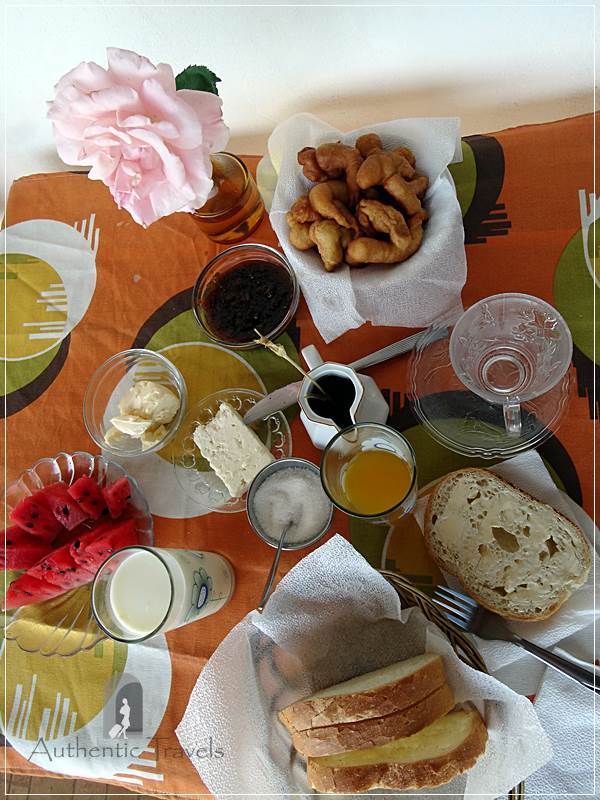
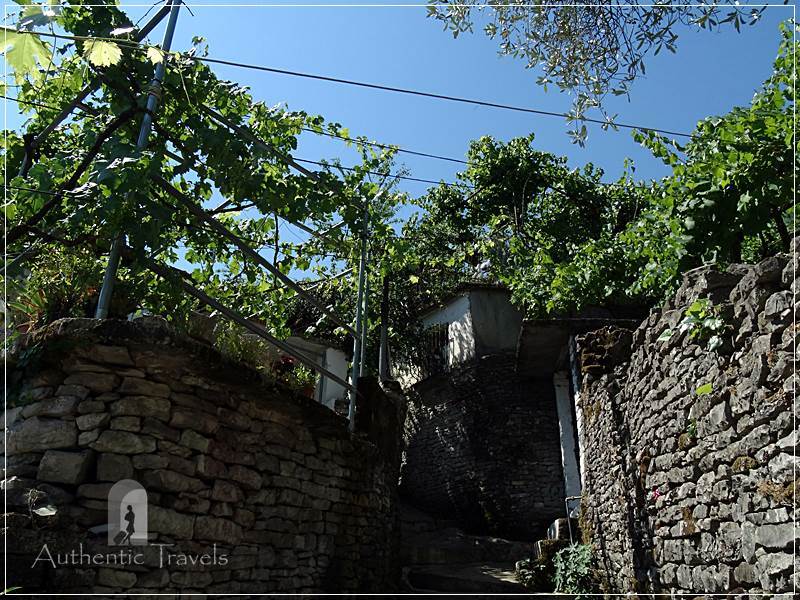
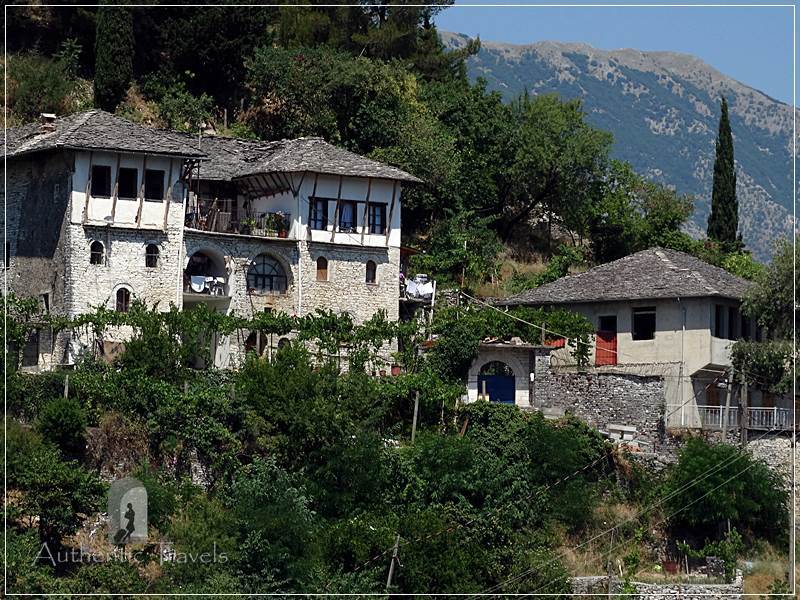
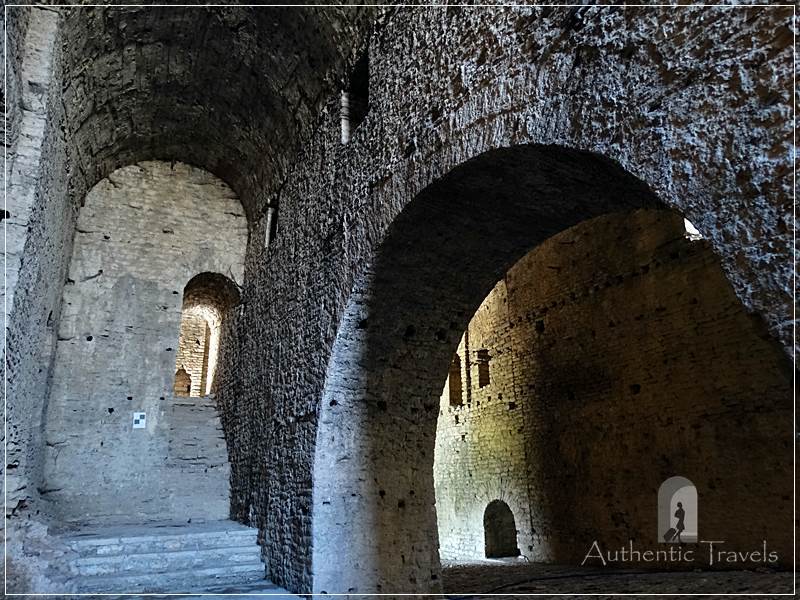
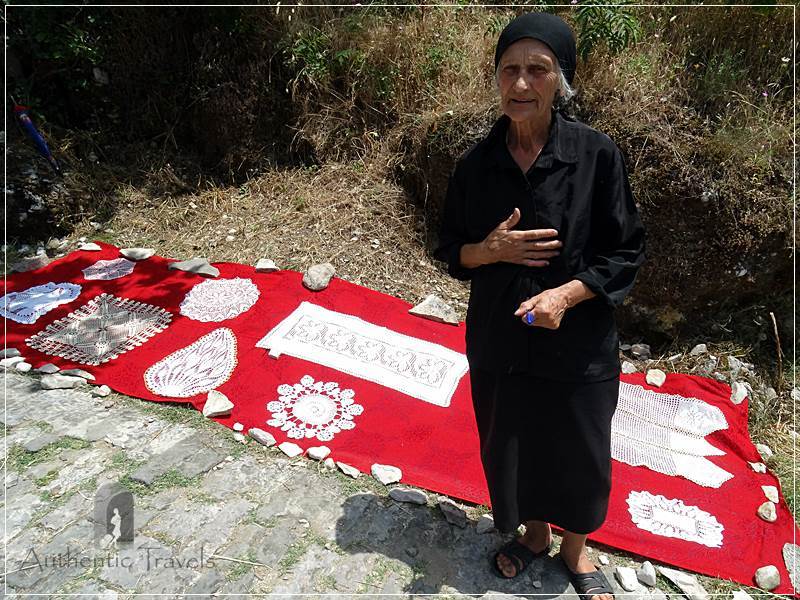
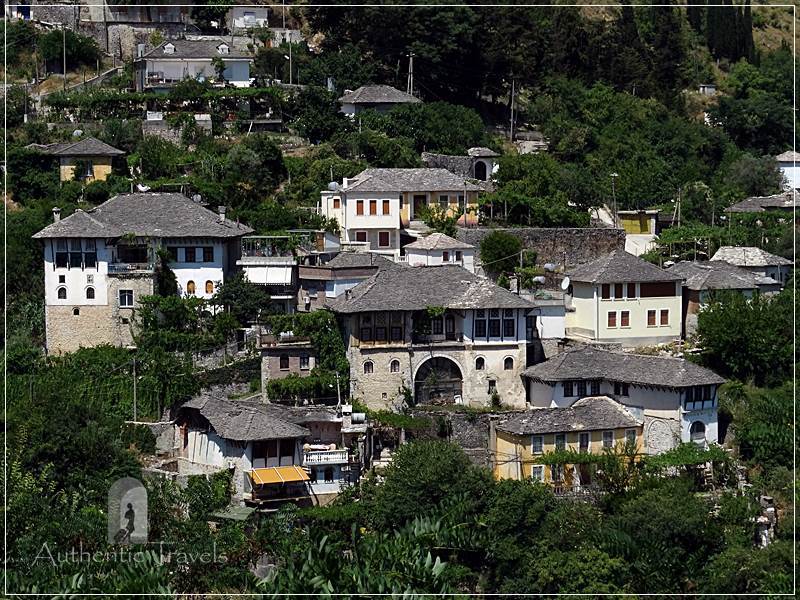
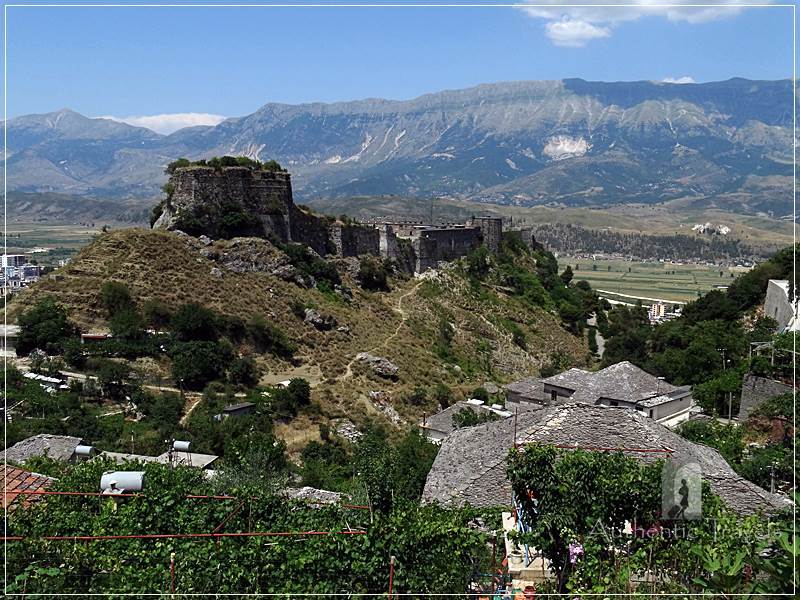
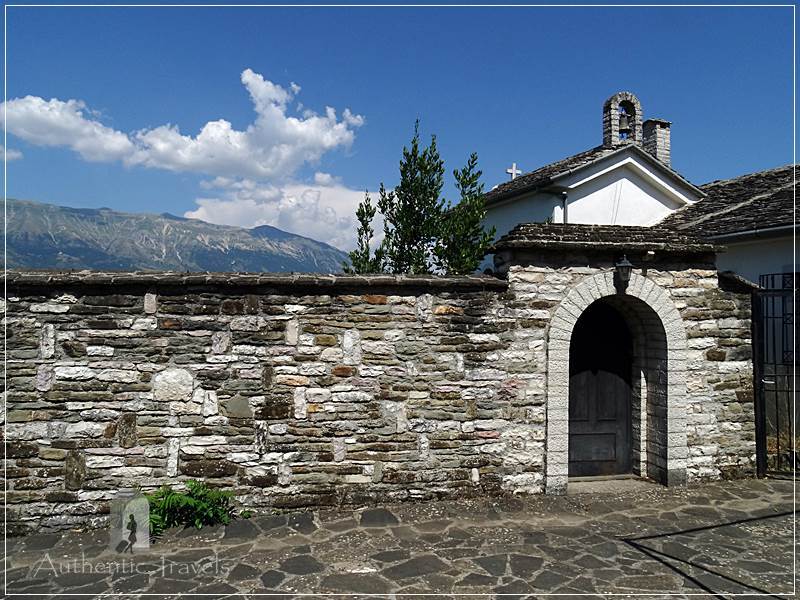
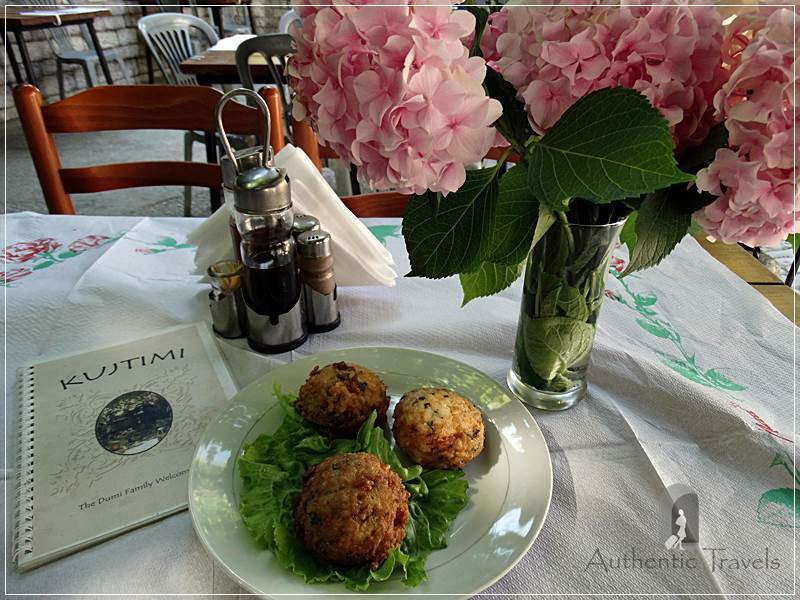
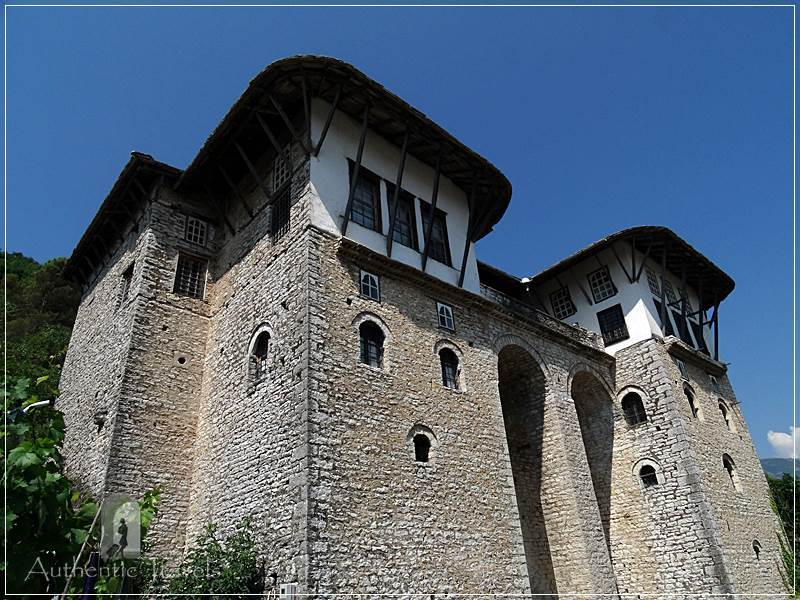
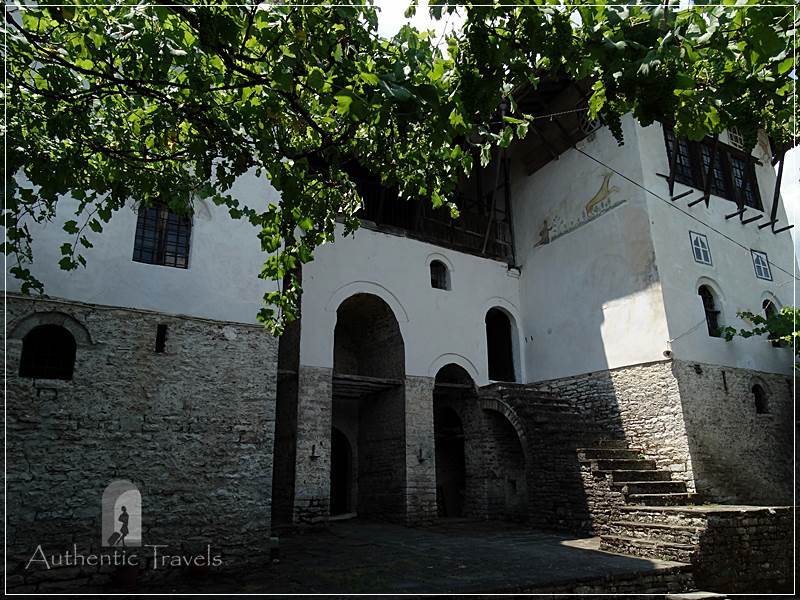
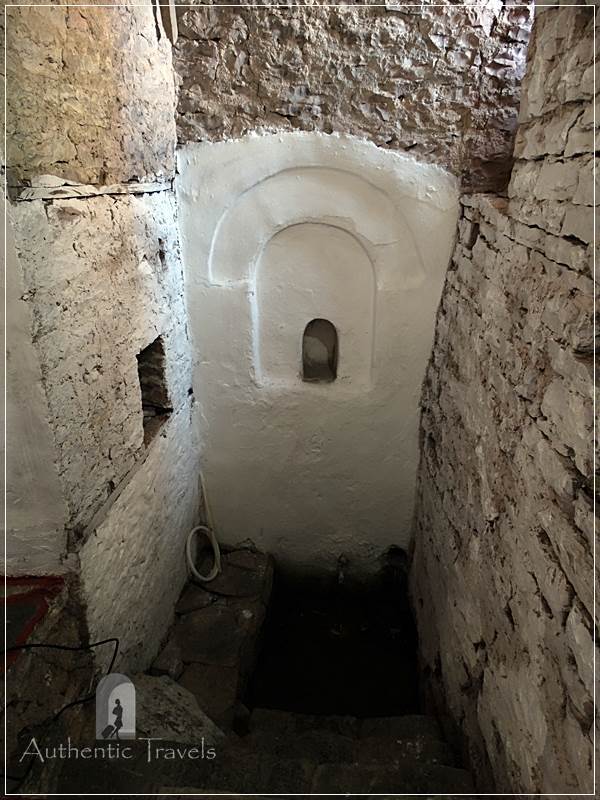
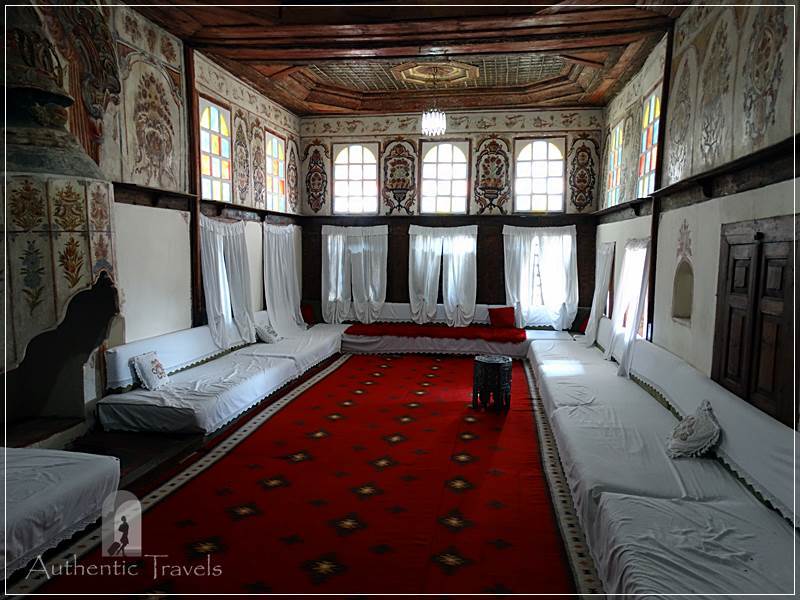
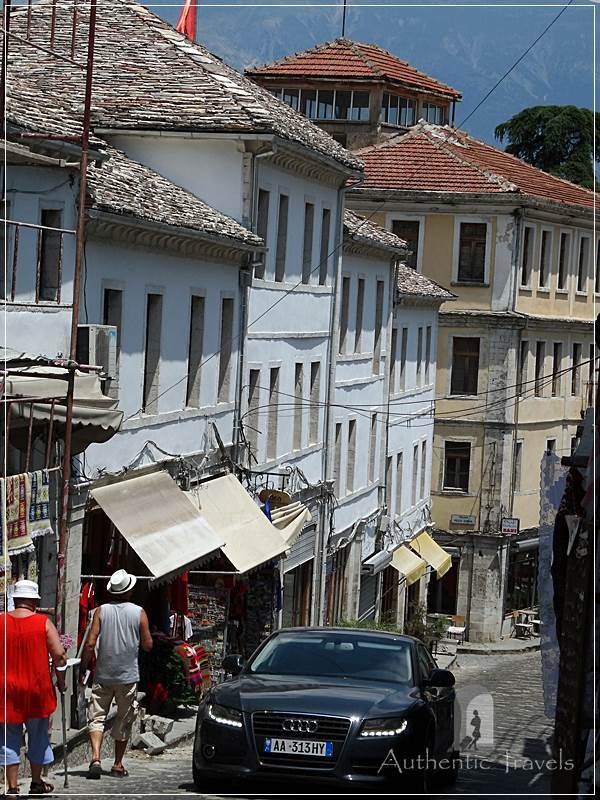
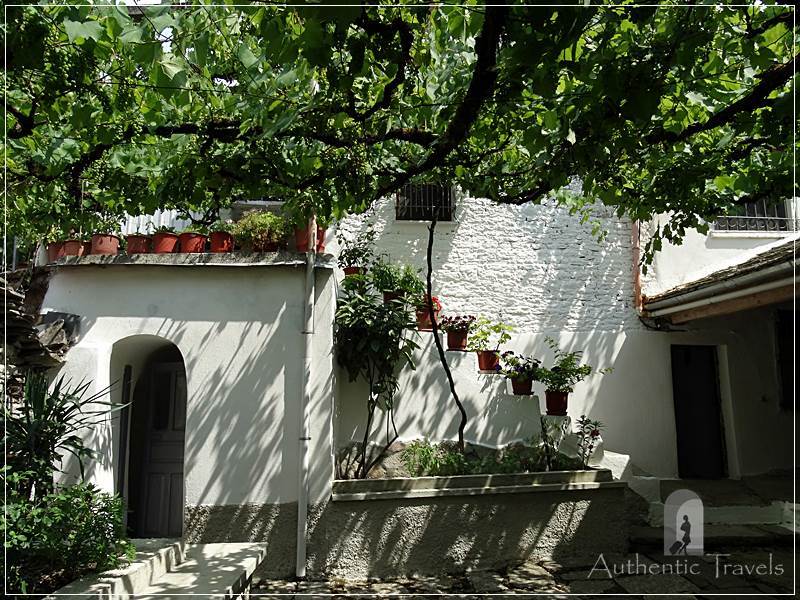
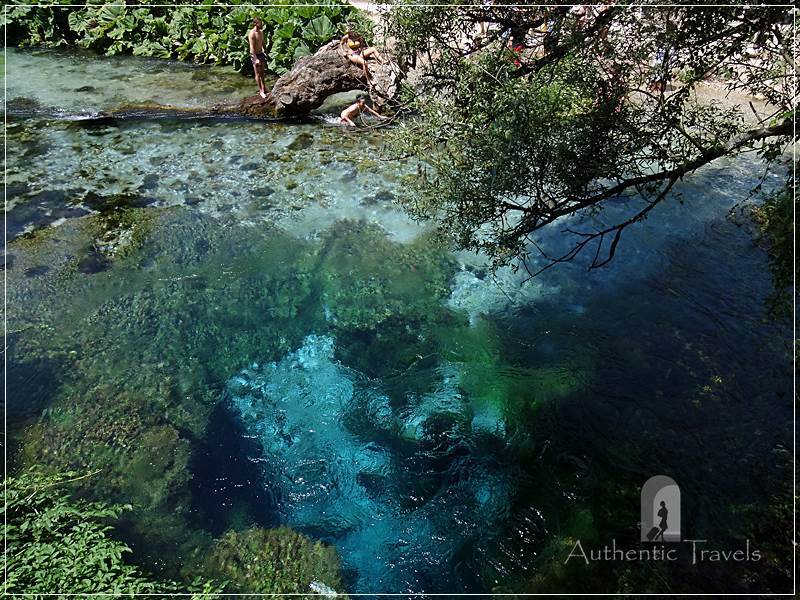
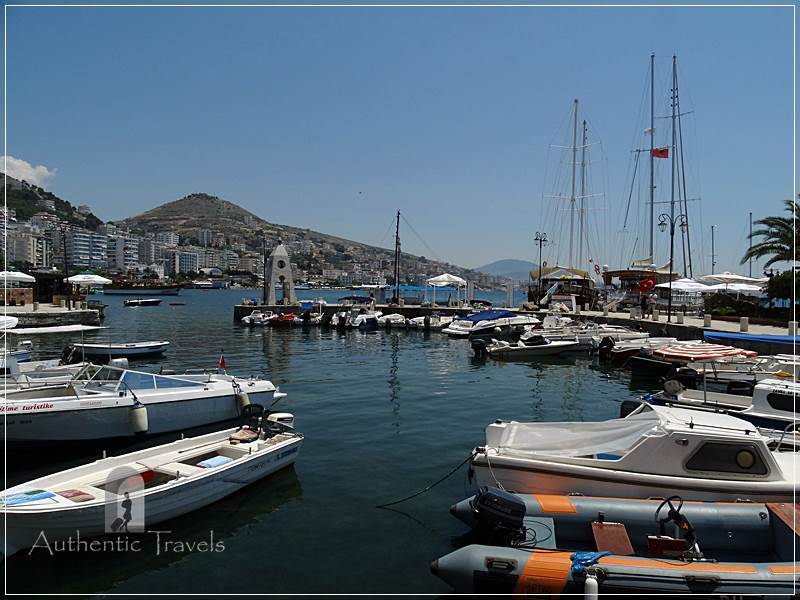
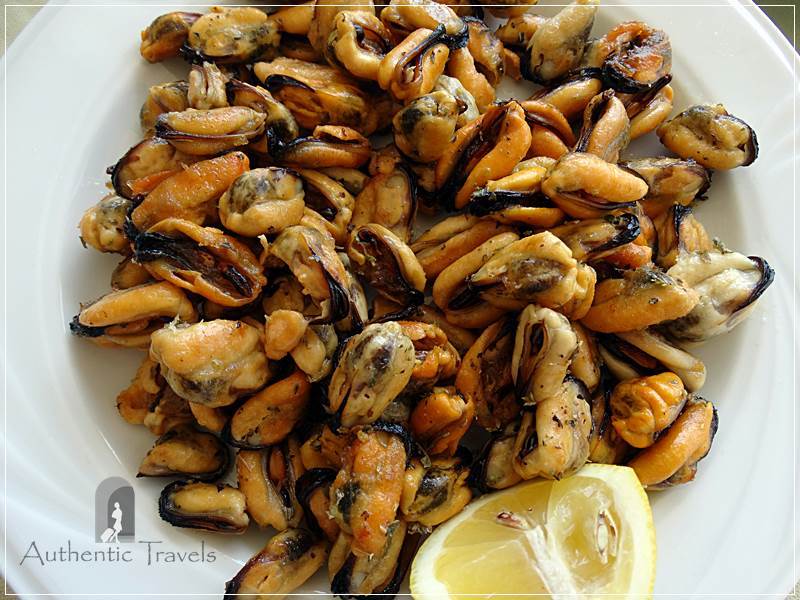
Wow! It’s morning here and I haven’t eaten yet so the breakfast at Mele Guesthouse looks especially delicious right now. If I didn’t know any better I would’ve thought a lot of these photos were from Italy. Albania looks so charming! I have to add it to my list now I think.
Albania is just across Italy, so maybe you’re right – they’re pretty similar countries.
From your photos, Gjirokastra looks so much like an abandoned ghost house. I’m not sure why, but I had an eerie feeling while going through them. The interiors of the houses you photographed however, look grand and inviting. I do not admittedly know much about Albania, but this seems like an interesting part of the country to visit.
The historic town of Gjirokastra looks fascinating with those age-old stone buildings. Your pictures of the Ottoman houses and the fortress are exceptional they are like a time-warp. And the crystal clear blue lake on the way to Sarande is surreal indeed. We are yet to make it to this part of the world. Albania is definitely on our bucket list.
Wow, Albania looks like a fantastic place to visit! I would love to see more of these Ottoman houses, the architecture and the landscape seem to be breathtaking! Thanks for sharing your experiences!
I love getting to live vicariously through your travels! I’m hoping to visit Albania in 2019, so I’m taking notes! I generally try to avoid having to rent a car, but this makes it seem like I’d be missing out if I didn’t venture out on four wheels.
Thanks for showing me all these cool pictures and amazing places to go. I have still not made it to Albania, but it is really high on my list. I am now waiting for the winter to pass, but will definitely go this summer. Thanks for the tips.
Wow, I would be very happy to traipse my feet on a cobblestone narrow alley flanked by two massive whitewashed walls and just amble around. The view from where you get yourself is really breathtaking and I can really feel the cold breeze touched my surface. I have not heard about this place, and will surely include this in my bucket list. Thank you so much for sharing this with us.
Wow your trip sounds awesome! Your food pictures have now made me super hungry! Sounds like you had a great experience – thanks for the inspiration!
I havent heard of Ksamil or Gjirokastra before. I love reading your blog because you visit places that are not tourist traps. Blue Eye Spring looks amazing, would love to see that. Gjirokastra also looks very interesting. I hope I can visit Albania soon 😀 Thank you for letting me know about this place 😀
My favorite part of this article was the human-to-human connection you had with the lady selling embroidery. How lovely that she thanked you by kissing your hand, so genuinely sweet and heartfelt.
I would also like to try the breakfast at Mele Guesthouse. Breakfast is my favorite meal of the day and it looks like they do a great offering. I think it’s great that you are covering lesser-known spots and I hope that this will encourage more people to go to Albania. It’s definitely on my list now!
Albania is a great tourist spot, less expensive than Italy but with the same seaside/beaches. Totally agree with you regarding breakfast, especially when traveling.
The Blue Eye looks amazing! I would like to think I would be jumping in too…But I would probably be like you and just about manage to dip my feet in haha. Looks like you had a great time there, thanks for sharing!
I have never been to Gjirokastra or even heard of it, but this post made me interested in going. Albania seems like a country with really rich history. I loved the look of the Ottoman houses and it was interesting reading about how they built them on a slope. The mussels look amazing too!
Never thought Albania is so charming. I haven’t even known much about it, but had some apprehensions about the safety there though ? If its safe, I am sure going to add this to the list since its so charming. Love the greenery courtyard with vines of the Mele Guesthouse
The side roads are very bad in Albania – maybe it’s dangerous to go there. But if you fo in the tourist areas, you don’t have any problem. They are keen to have tourists, everything is very cheap, so nobody will harm you.
I love knowing about new countries, their heritage and food. Makes me want to visit 🙂
I really enjoyed reading your post ! Albania has the two most important things that I dig – history (fortresses) and food – and from your beautiful pictures I’m not sure which ones I will pick! Everything is so real and beautiful
I’ve never been to Albania, so really haven’t heard of Gjirokastra. It looks so picturesque, and with so much Ottoman influence too. I like those houses here, they look unlike any home structure I’ve seen before! The food looks interesting too, especially those fried mussels with lemon, yum!